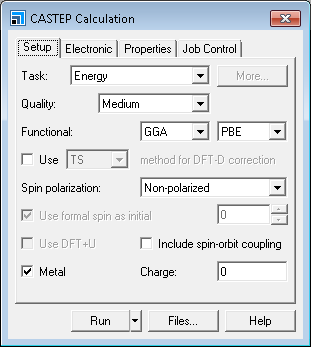
- #Determine Volume Materials Studio Software For Atomistic
- #Determine Volume Materials Studio Free And Truly

If it is just one object once then you can type the following into the Python window, Code: Select all. They also support creating phonon dispersion and DOS plots.'Total area of finished, above-grade residential space calculated by measuring the outside perimeter of the structure and includes only finished, habitable, above-grade living space' is the definition ofby jmaustpc Sun 11:43 pm. dispersion.pl and dos.pl are tools for producing band-structure and density of states plots from a CASTEP. Apparent volume of irregularly shaped samples may be determined by solid or liquid displacement methods.


CrystalMaker is a visualisation suite for designing and investigating crystal and molecular structures. Doi: 10.1088/0953-8984/01. Peter Brommer and David Quigley (2014) "Automated effective band structures for defective and mismatched supercells." J. It implements the effective band structure method described by Popescu and Zunger doi: 10.1103/PhysRevB.85.085201, and is distributed as part of the CASTEP academic distribution.
Determine Volume Materials Studio Software For Atomistic
OVITO is a scientific visualization and analysis software for atomistic and particle simulation data. MagResView is a tool for visualization and processing of computed solid-state NMR parameters. JMOL is an open-source browser-based HTML5 viewer and stand-alone Java viewer for chemical structures in 3D with features for molecules, crystals, materials, and biomolecules.
The NOMAD Repository is also the only repository in Computational Materials Science that is recommended by NATURE Scientific Data. Storing is guaranteed for at least 10 years, a requirement set by several funding agencies. The service includes uploading, downloading, sharing, assigning DOIs, and more. NOMAD supports CASTEP and its users. XCrysDen is a crystalline and molecular structure visualisation program aiming at display of isosurfaces and contours, which can be superimposed on crystalline structures and interactively rotated and manipulated.
The sensible random structures are constructed so that they have reasonable densities, and atomic separations. It generates random sensible structures and relaxes them to nearby minima. AIRSS( Ab initio Random Structure Searching) is a very simple, yet powerful and highly parallel, approach to structure prediction.
The approach requires only chemical compositions for a given compound to predict stable or metastable structures at given external conditions and can be used to predict/determine the crystal structure and design multi-functional materials. Calypso( Crystal structure AnaLYsis by Particle Swarm Optimization) is an efficient structure prediction code. It is tightly integrated with CASTEP and has been used in a number of landmark studies to find novel phases of materials. Beyond these explicit constraints the emphasis is on a broad, uniform, sampling of structure space.
Determine Volume Materials Studio Free And Truly
ShengBTE is a software package for solving the Boltzmann Transport Equation for phonons. MDTEP is a simple code for analysing MD trajectories and calculating thermodynamic properties such as the heat capacity and the velocity autocorrelation function. MDANSE ( Molecular Dynamics Analysis for Neutron Scattering Experiments) is a python application designed for computing properties that can be directly compared with neutron scattering experiments such as the coherent and incoherent intermediate scattering functions and their Fourier transforms, the elastic incoherent structure factor, the static coherent structure factor or the radial distribution function. XtalOPT is a free and truly open source evolutionary algorithm designed for a priori crystal structure prediction implemented as an extension to the Avogadro molecular editor. In addition to this fully non-empirical search, USPEX allows one to predict also a large set of robust metastable structures and perform several types of simulations using various degrees of prior knowledge. It can very efficiently handle molecular crystals (including those with flexible and very complex molecules) and can predict stable chemical compositions and corresponding crystal structures, given just the names of the chemical elements.
One of the most typical uses of BoltzTraP is the calculation of thermoelectric transport coefficients as functions of temperature and chemical potential in the rigid-band picture. BoltzTrap2 is a modern implementation of the smoothed Fourier interpolation algorithm for electronic bands that formed the base of the original and widely used BoltzTraP code. BoltzTraP is a program for calculating the semi-classic transport coefficients. AlmaBTE extends the ShengBTE approach currently employed for homogeneous bulk materials, into the mesoscale, to fully describe thermal transport from the electronic ab initio level, through the atomistic one, all the way into the mesoscopic structure level.
Wannier90 is a tool for obtaining maximally-localised Wannier functions. There are two versions of the program: written in FORTRAN and Python. EMC( Effective Mass Calculator) implements calculation of the effective masses at the bands extrema using finite difference method.
bader is a tool to perform Bader charge analysis on a charge density grid. It can interface with many different electronic structure codes. The code is freely available under the GNU LGPL license.
ATAT (Alloy Theoretic Automated Toolkit) is a collection of alloy theory tools developed by Axel van de Walle. For example, the charge enclosed within the Bader volume is a good approximation to the total electronic charge of an atom. Besides being an intuitive scheme for visualizing atoms in molecules, Bader's definition is often useful for charge analysis.
Its functionality has since been rolled into c2x. CellSymm is a simple C front-end for the spglib symmetry finding code. It is capable of calculating incredibly accurate solutions to the Schrödinger equation of quantum mechanics for realistic systems built from atoms.
It provides a number of classes and functions to handle large amounts of candidate structures, compare them, sort them and cluster them. Soprano is a Python library meant to help crystallographers with the search and classification of new crystal forms for a given material.


 0 kommentar(er)
0 kommentar(er)
